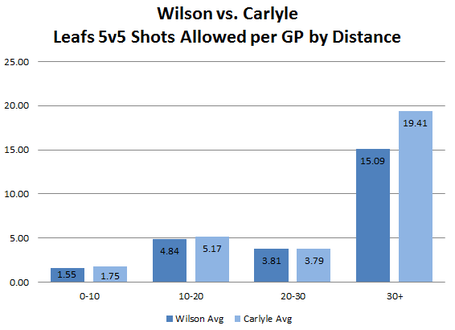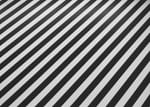On February 25th, 2013 I posted this article about Randy Carlyle and the effects of his defensive systems on shot distances. Much more recently James Mirtle wrote this piece about Carlyle's defensive ineptitude that preceded his departure from Anaheim and has subsequently led to a decline here in Leafland. There are also postings such as this on the Leafs Defensive Systems by Gus Katsaros, making the firm distinction that Carlyle is a strong proponent of pushing shots to the outside. Here is a quote from an Elliotte Friedman article referencing Carlyle's logic with respect to allowing outside shots courtesy Bobby Ryan:
[Bobby] Ryan said there was one on-ice adjustment with his transition from Anaheim to Ottawa. Senators head coach Paul MacLean wants his forwards to engage opponents who go to the half-wall with the puck in the defensive zone. Ryan remembers then-Ducks head coach Randy Carlyle demanding they stay in the middle of the ice. "If the goalie can’t stop it from out there, we’ll get another one," Ryan said Carlyle would say.
Some key points and information from the earlier posting I wrote that we might like to revisit. Here is a chart comparing Wilson and Carlyle's team's shot allowances by distance from 2008 through 2011:
Now obviously it would help if we could throw in the last 2 season's worth of data, but unfortunately we only have 48 games worth of data from 2012-13. To that end, I'm going to change the scale of the graph to a shots allowed per game basis and rather than compare Anaheim to Toronto, I'm going to compare Wilson's average shots allowed to Carlyle's while the Leafs have operated under their coaching. This gives us the following graph for comparison:
So, the main distinction drawn on behalf of Carlyle when he was first hired by the Leafs was that he was going to implement a defensive structure that would push shots to the outside. He's SORT of done that. The Leafs definitely have more shots coming in on net from the outside areas of the ice than the inside. Unfortunately, they haven't seem to be able to cut down on the shots from the inside effectively either. Examining the shot rates per game above and using the following average save percentages by distance for the Leafs over this time frame, we get the following expected goal results in an 82 game season.
| Avg SV% | Wilson Exp GA | Carlyle Exp GA |
|---|---|---|
| 0.864 | 17.335 | 19.590 |
| 0.840 | 63.651 | 68.026 |
| 0.898 | 32.017 | 31.784 |
| 0.954 | 57.317 | 73.712 |
| Exp GA TOT | 170.320 | 193.111 |
So assuming the Leafs were to get decent to average goaltending (which they've largely gotten over the last 3-4 years), Randy Carlyle's defensive "systems" would project to result in an extra 23 goals against per season at 5v5. If we project that approximately 5.8 goals is a marginal win or loss, this translates to an astounding difference of 3.9 wins per season, or more specifically, 7.9 points in the standings.
Randy Carlyle has run this team into the ground defensively and it's gotten progressively worse. If you want to know what that's worth to the franchise, consider the fact that the value of a marginal win in the standings was most recently estimated at $2.23 M for a UFA signing by Gabe Desjardins here. Using the past 3 years of wins and point totals for the NHL we can calculate that the number of points per win is 2.24, so the cost per marginal point is $995,536 and basically Randy Carlyle is making it seem like the Leafs are operating with a salary cap that is reduced by approximately $7.86 million. Talk about hamstringing a team. The man is among the most costly coach in the NHL. I'd ask you to attempt to convince me that Carlyle should stay but at this point I'm not sure what that argument could possibly entail.






Comment Markdown
Inline Styles
Bold: **Text**
Italics: *Text*
Both: ***Text***
Strikethrough: ~~Text~~
Code: `Text` used as sarcasm font at PPP
Spoiler: !!Text!!